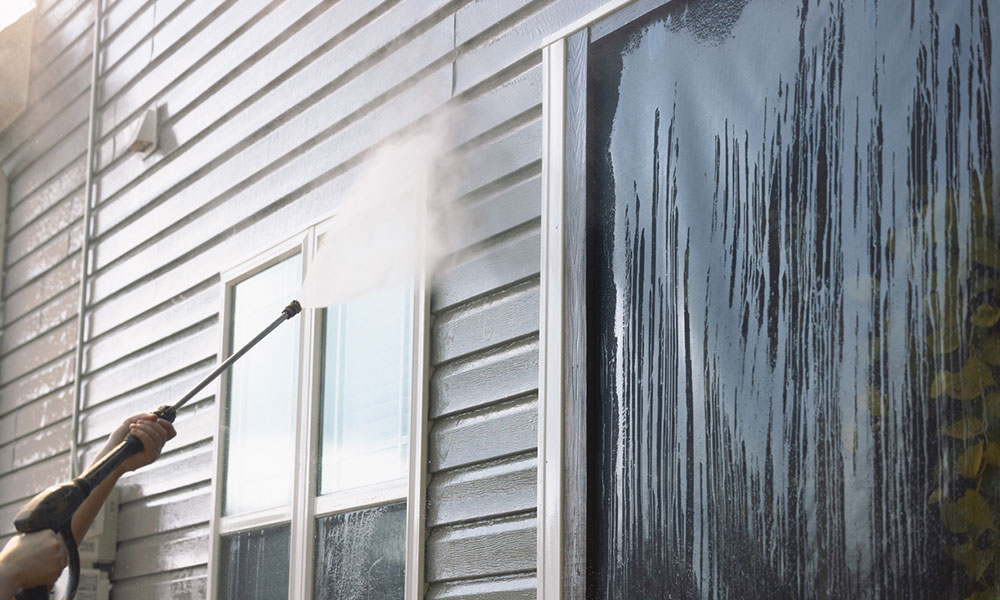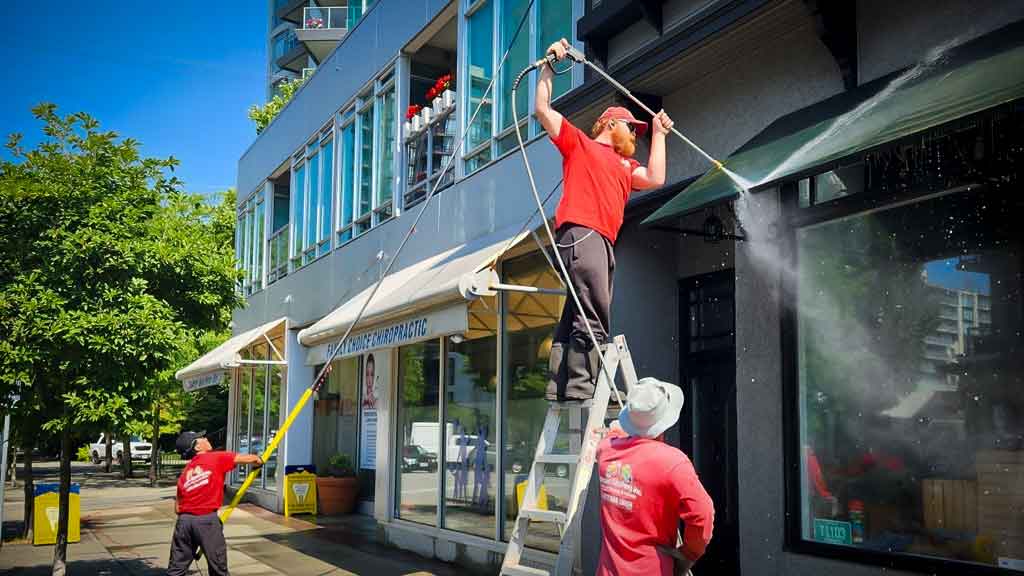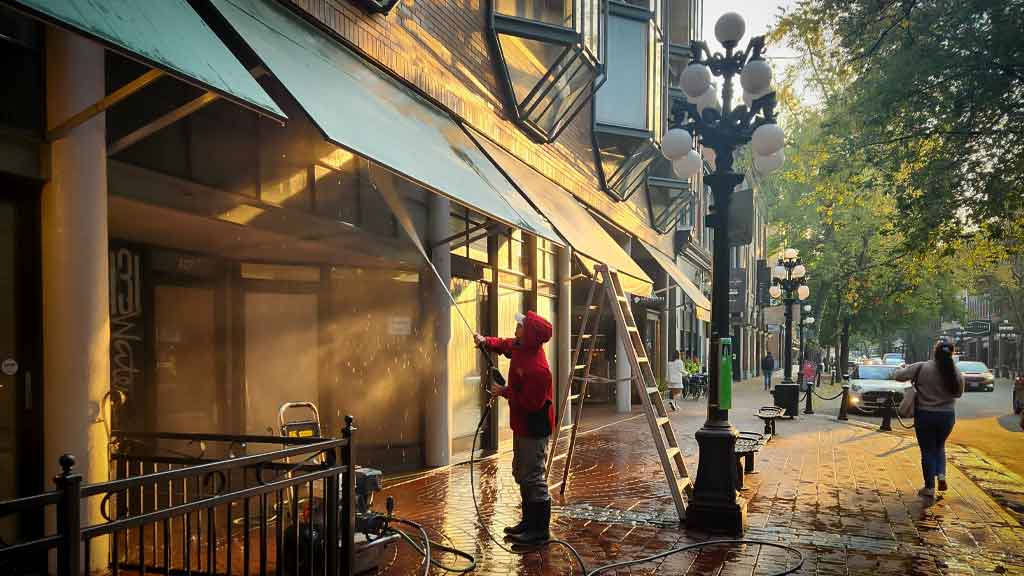Brush Washing vs. Power Washing: Which is Better for Your Home’s Exterior?
If you’ve ever stood outside, coffee in hand, glaring at your home’s siding and thinking, “It wasn’t that shade of green last year,” you’re not alone. We’ve all been there, watching dirt, algae, mildew, and mysterious stains slowly take over after a rainy winter in Metro Vancouver.
At Maple Washing, we’ve seen everything from mossy siding to decks so slick they could host a curling tournament. And when it comes to cleaning your home’s exterior, homeowners often wonder which method works best, Brush Washing, Power Washing or a combination of both.
It’s not just about making your house look clean; it’s about protecting your home, preserving its exterior finishes, and doing it in a way that fits your budget, schedule, and values.
Both approaches have their strengths and weaknesses, and the right choice depends on your home’s materials, the type of grime present, and your cleaning priorities.
Before picking up a hose or calling in the pros, it’s worth understanding what each method involves. Let’s break it down, share a few real-world stories, and help you figure out which exterior cleaning technique will leave your home looking its best, without stripping paint, damaging siding, or turning your backyard into a mudslide.
The Great Debate: Choosing the Right House Washing Method
When you first hear the terms, you might think they’re just two ways to get the same job done. In reality, the brush and pressure washing comparison is about more than technique, it’s about results, safety, and long-term care for your home.
Manual washing is a hands-on, detail-oriented method that involves scrubbing surfaces with soft-bristle brushes and cleaning solutions. It’s slower but gentler, making it ideal for delicate materials or painted finishes that need protection.
Think of it like handwashing your car instead of an aggressive automatic wash, it’s about control and care.
Power washing (also called pressure washing) takes the opposite approach: high-pressure water blasting away dirt, mold, and debris in minutes.
It’s satisfying to watch and can transform surfaces that have been neglected for years. But that power also comes with risks, especially for softer materials. Please use caution or give us a call as we have a ton of experience in this department.
At Maple Washing, we’ve worked on everything from century-old heritage homes in New Westminster to modern vinyl-sided houses in Coquitlam.
The right choice of exterior cleaning method depends on your home’s needs, and sometimes the best solution combines both techniques.
What is Brush Washing?
Brush washing is like giving your home a spa treatment, slow, soothing, and tailored to the siding’s specific “skin type.” This house washing technique uses soft brushes and gentle, eco-friendly solutions to remove grime, algae, and mildew without causing damage.
Because it’s deliberate, this allows for precision. We can reach tricky corners, work around fragile trim, and target stubborn spots safely.
It’s also environmentally friendly, using less water than pressure washing, and our solutions are safe for plants, pets, and local waterways in Metro Vancouver.
One memorable job was in North Vancouver on a 1940s character home. The owner was worried about losing paint after a prior bad experience with a pressure washer.
Using brushes, the siding looked fresh and bright in a few hours, without a single chip lost. She said it felt like her house had been “pampered” rather than attacked.
What is Power Washing?
If precision cleaning is a spa day, pressure washing is a boot camp for your home’s exterior. Using a powerful water jet (often over 2,000 PSI), it removes dirt, grime, mold, and buildup quickly.
It’s ideal for hard surfaces like concrete, brick, and heavily soiled vinyl siding.
The main advantage of pressure washing is speed. Entire patios in Surrey have gone from moss-covered “no-go zones” to spotless outdoor spaces in under an hour.
Watching years of grime vanish in real-time is oddly satisfying and can make your home feel years younger.
However, high pressure requires caution. On softer surfaces like wood, painted finishes, or certain composites, it can etch, strip paint, or force water behind siding, causing costly issues later.
At Maple Washing, we assess each surface before cleaning. We adjust pressure and angle to ensure effective yet safe results. For hard, durable surfaces, pressure washing is fast and efficient; for delicate areas, brush washing is often recommended first.
Which is Better for Your Home?
Choosing the right house washing method depends entirely on your property’s needs. For instance, newer vinyl siding coated in a winter’s worth of grime may respond beautifully to pressure washing.
On the other hand, a century-old heritage home in New Westminster with delicate trim may benefit from the careful touch to protect the paint.
If speed and heavy-duty cleaning are your priority, pressure washing often works best. If surface preservation and detail matter more, brush is the safer option. Often, the smartest route is a tailored combination of both techniques.
The Hybrid Approach
Sometimes, the question isn’t “either/or,” it’s “both.” This is especially true when a property has multiple surfaces that require different care.
Imagine painted wood siding, an oil-stained concrete driveway, and a composite deck. Using just one method could damage the siding or extend the project unnecessarily.
Instead, we start with brush washing on the siding to protect it, switch to pressure washing for the driveway to restore its brightness, and then use a split approach on the deck, soft brushing for the railings and controlled pressure for the boards.
This hybrid strategy saves time and water while delivering consistent results across all surfaces. Homeowners in Burnaby, Coquitlam, and North Vancouver appreciate this custom approach because it keeps their property looking uniform and professionally maintained.
The Environmental Factor
Environmental responsibility is a key consideration in Metro Vancouver. That’s why choosing a house washing technique often comes down to water use and cleaning products.
Brush typically uses less water since it relies more on mechanical scrubbing than blasting.
At Maple Washing, we combine this with biodegradable, ocean-safe cleaning solutions that break down naturally without harming plants, pets, or waterways.
Pressure washing can also be eco-friendly when done properly. We use modern, water-efficient equipment and responsible runoff control. The goal is not to avoid one method, but to use the right approach for a spotless home without leaving an environmental footprint.
Safety Matters
House washing carries some safety risks. Brush involves working at heights, balancing on ladders, and handling cleaning solutions near plants and windows. Pressure washing carries higher stakes, high-pressure water can injure or damage siding if used incorrectly.
DIY attempts often go wrong, from etched siding to water forced behind panels, creating hidden mold problems. That’s why Maple Washing uses trained professionals, correct PSI settings, and proper nozzles. Safety is as much about skill as it is about equipment.
How to Choose the Right Service
If you’re unsure which approach to take, start with these questions:
- What is my exterior made of?
- What’s the surface condition, fresh paint or peeling layers?
- How heavy is the dirt buildup?
- Do I prioritize speed, detail, or preservation?
- Are environmental considerations important to me?
When you contact Maple Washing, we guide you through these questions and provide honest recommendations because house washing should focus on what’s best for your home, not just speed.
Maple Washing’s Recommendation for Exterior Cleaning Methods
After years of cleaning homes from Burnaby to Richmond, here’s our professional take: neither brush nor pressure is “better” in every case.
Delicate, historic, or recently painted homes benefit from brush. Tough, grimy surfaces needing a fast transformation often require pressure washing.
Most house washing projects achieve the best results by using both methods in the right places.
FAQ: Which is Better for Your Business or Home’s Exterior?
What is the difference between brush and power?
Brush uses soft-bristle brushes and gentle cleaning solutions for a detailed, gentle clean. Power washing uses high-pressure water to remove dirt and grime quickly but may risk surface damage if not used properly.
Which method is safer for delicate home exteriors?
Brush is safer for delicate surfaces such as painted wood, cedar, or heritage homes because it’s gentler and less likely to cause damage.
Is power washing more effective than brush?
Power washing is more effective for cleaning large, hard surfaces like driveways, brick, and heavily soiled siding. Brush washing is better for detail work and delicate surfaces.
Which method is more eco-friendly?
Can I combine brush and power washing?
Yes. A hybrid approach often gives the best results—using brush washing for delicate areas and power washing for tough, durable surfaces.
Final Thought
Choosing between a gentle brush wash or a high-pressure clean isn’t about crowning a winner, it’s about selecting the right method for your home’s surfaces. Maple Washing brings experience, the right equipment, and eco-friendly solutions to ensure your property looks its best.
Phone: 1-877-888-9274
Email: info@maplewashing.com
Serving Burnaby, Coquitlam, Surrey, Richmond, North Vancouver, and the surrounding Metro Vancouver areas.


